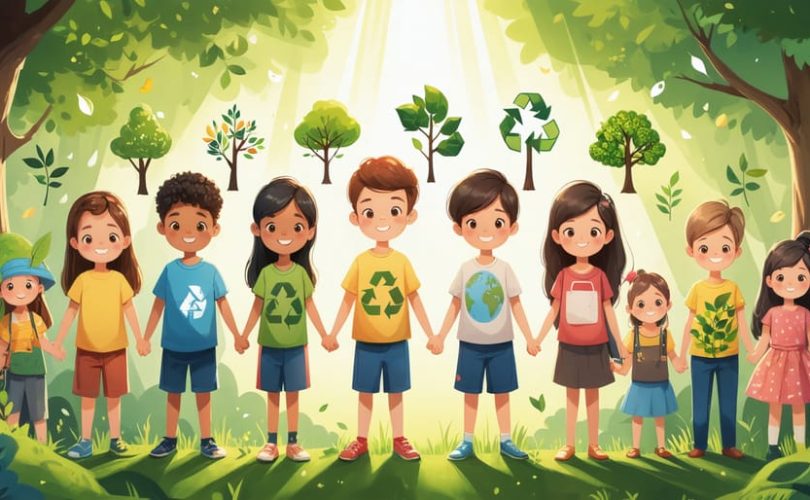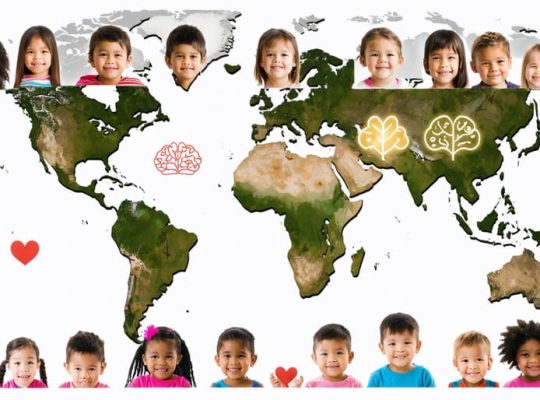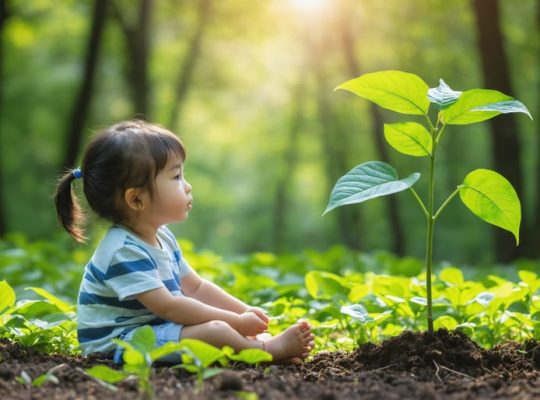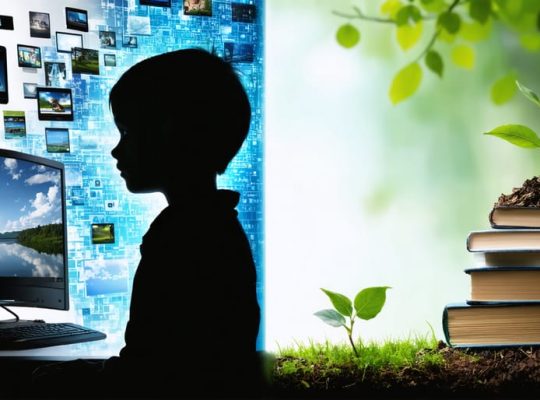Climate change isn’t just transforming our physical world – it’s profoundly impacting our mental well-being and that of our children. As parents and caregivers watch rising temperatures, extreme weather events, and environmental challenges unfold, many are noticing increased anxiety, stress, and emotional struggles in their families. Recent studies reveal that up to 45% of children and young people report experiencing “climate anxiety,” with these feelings intensifying as they become more aware of environmental changes.
This growing phenomenon, often called “eco-anxiety” or “climate distress,” manifests differently across age groups and individuals. While some children express their concerns through direct questions about the planet’s future, others might show subtle signs like changes in sleep patterns, increased irritability, or withdrawal from activities they once enjoyed. Parents often feel caught between protecting their children’s emotional well-being and preparing them for environmental realities.
Understanding the connection between climate change and mental health is crucial for providing effective support. Whether you’re a parent, educator, or healthcare provider, recognizing these emotional responses as valid and learning to address them constructively can help build resilience in the face of environmental challenges. This article explores the psychological impact of climate change, offering practical strategies to support mental wellness while fostering hope and empowerment.
How Children Process Climate Change Information

Age-Specific Reactions and Understanding
Different age groups process and react to climate change information in distinct ways that significantly impact their child’s emotional development. Young children (ages 4-7) often express their anxiety through physical complaints like stomach aches or through changes in play patterns. They may struggle to verbalize their concerns but show their worry through drawings or storytelling.
Pre-teens (ages 8-12) typically demonstrate a more concrete understanding of environmental issues and may express feelings of helplessness or anger. They’re likely to ask detailed questions about climate change and show genuine concern for animals and nature affected by environmental changes.
Teenagers often experience more intense emotional responses, including eco-anxiety and depression. Their broader understanding of global implications can lead to feelings of frustration with adult inaction and a strong desire to participate in climate activism.
Young adults may feel overwhelmed by the responsibility of inheriting environmental challenges, leading to climate grief and uncertainty about their future. Their reactions often combine emotional response with practical action, driving them to seek solutions and make lifestyle changes.
Common Emotional Responses
Children often experience a range of emotional responses when learning about and processing climate change information. Many show signs of anxiety, expressing worry about the future of our planet and the well-being of animals they love. Just as with digital media exposure, these concerns can manifest in various ways.
Common emotional reactions include feelings of helplessness when faced with such a large-scale issue, sadness about environmental losses, and fear about what the future might hold. Some children may become angry or frustrated, especially when they feel adults aren’t doing enough to address the problem. Others might experience guilt about their own environmental impact or feel overwhelmed by the responsibility to “save the planet.”
It’s also normal for children to show signs of emotional distress through changes in behavior, such as becoming more clingy, having trouble sleeping, or losing interest in previously enjoyed activities. Some may express their feelings through art or play, while others might become more vocal about environmental issues or show increased interest in taking action.
Remember that these responses are natural and valid ways of processing complex environmental information. Each child will react differently based on their age, personality, and exposure to climate-related information.
Signs of Climate-Related Anxiety in Children
Physical Symptoms
Climate anxiety and environmental stress can manifest in various physical symptoms that parents and caregivers should be aware of. Children and teens may experience headaches, stomach aches, or changes in appetite when confronted with climate-related news or discussions. Some young people report difficulty sleeping, with climate-related nightmares disrupting their rest patterns.
Dr. Sarah Martinez, a child psychologist, notes that “Many children experience tension in their shoulders and jaw, particularly after exposure to climate disaster footage or discussions about environmental threats.” These physical responses are natural stress reactions, similar to how our bodies respond to other types of anxiety.
Common physical symptoms include:
– Fatigue and low energy levels
– Muscle tension and body aches
– Rapid heartbeat or breathing, especially when discussing climate issues
– Digestive problems
– Changes in sleep patterns
– Reduced immune function
Parents often share stories of their children developing these symptoms after learning about environmental challenges. Lisa, a mother of two, recalls, “My 12-year-old daughter started having frequent stomach aches after her class project on ocean pollution. We learned to balance her awareness with positive action, which helped reduce these symptoms.”
Remember that these physical manifestations are your child’s body responding to genuine concerns. Acknowledging these symptoms while providing support and coping strategies can help children manage their physical responses to climate-related stress more effectively.
Behavioral Changes
As parents, it’s crucial to recognize changes in your child’s behavior that may signal climate anxiety. Children often express their concerns differently than adults, and these signs can manifest in various ways depending on their age and personality.
Common behavioral changes to watch for include increased irritability, difficulty concentrating, or changes in sleep patterns. Some children may become more clingy or show regression in previously mastered skills. Others might express their anxiety through physical complaints like stomachaches or headaches, especially before or after exposure to climate-related news.
You may notice your child becoming increasingly preoccupied with environmental issues, asking repetitive questions about natural disasters, or showing heightened distress during extreme weather events. Some children might withdraw from outdoor activities they previously enjoyed or become overly anxious about weather forecasts.
Changes in eating habits, decreased interest in activities, or sudden mood swings could also indicate underlying climate-related stress. Dr. Sarah Martinez, a child psychologist, notes, “Children may express their climate anxiety through seemingly unrelated behaviors. For instance, becoming extremely rigid about recycling or showing distress when family members don’t follow environmental practices.”
Watch for signs of hopelessness in conversations about the future or excessive guilt about personal environmental impact. These behavioral changes, while concerning, are normal responses to climate awareness and can be addressed with appropriate support and guidance.
Supporting Your Child’s Mental Well-being
Creating Safe Spaces for Discussion
Creating a safe environment for discussions about climate change is crucial when supporting emotional well-being in children. Start by choosing a quiet, comfortable space where your child feels secure sharing their thoughts and feelings. Listen actively without judgment, and validate their emotions – whether they’re expressing fear, anger, or confusion about environmental changes.
Encourage open dialogue by asking gentle, open-ended questions like “What have you heard about climate change?” or “How does thinking about the environment make you feel?” This approach helps you understand their perspective and address specific concerns. Remember to maintain a calm, reassuring presence, even if you share similar worries.
Keep conversations age-appropriate and balanced. While it’s important to be honest about environmental challenges, focus on hope and action rather than dwelling on scary scenarios. Share positive stories about communities working together and highlight opportunities for making a difference, no matter how small.
Create regular check-in times where family members can share their thoughts about environmental issues. This routine helps normalize these discussions and provides consistent emotional support. If children seem particularly anxious, consider setting boundaries around news exposure and redirecting energy toward positive environmental activities the family can do together.
Remember that these conversations are ongoing, and it’s okay not to have all the answers. The goal is to create a supportive space where children feel heard and empowered rather than overwhelmed.
Empowering Through Action
Taking positive environmental action as a family can help children feel more empowered and less anxious about climate change. Start with simple activities like creating a home garden together, where children can witness the joy of growing their own food and connecting with nature. Even a few potted plants on a windowsill can make a difference.
Organize family recycling stations and make it fun by turning it into a sorting game. Children often feel proud when they understand how their actions help protect the environment. Consider starting a compost bin and let kids observe how kitchen scraps transform into rich soil for your garden.
Family bike rides or nature walks not only reduce carbon emissions but also provide opportunities for meaningful conversations about environmental stewardship while staying physically active. Participate in local beach or park cleanups together, showing children that many people working together can create positive change.
Get creative with upcycling projects, transforming old items into new treasures. This teaches resource conservation while fostering creativity. Encourage children to brainstorm their own eco-friendly initiatives, like starting an environmental club at school or organizing a neighborhood tree-planting event.
Remember to celebrate your family’s environmental achievements, no matter how small. These shared experiences create lasting memories while building resilience and hope for the future. When children feel they’re part of the solution, their eco-anxiety often decreases, replaced by a sense of purpose and capability.
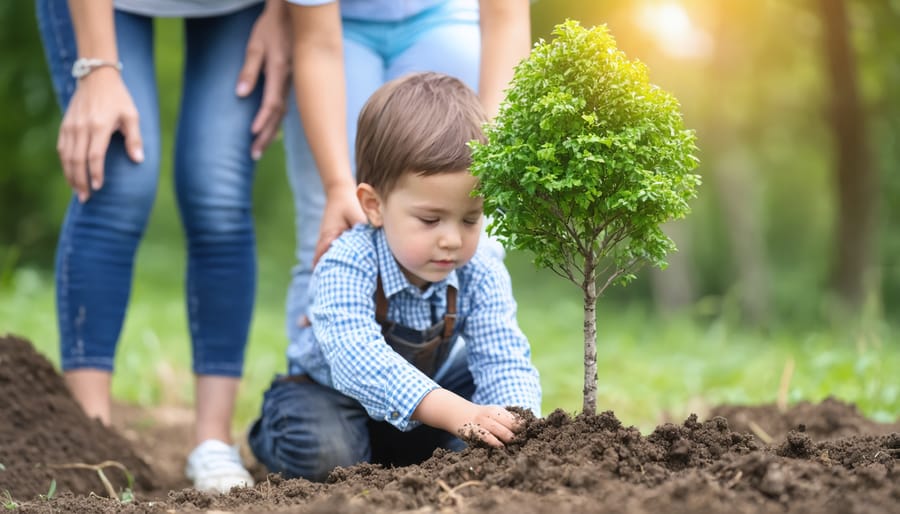
Building Emotional Resilience
Building emotional resilience in children is crucial as they face the realities of climate change. Parents and educators can implement several mental health support strategies to help children develop strong coping mechanisms.
Start by creating a safe space for children to express their feelings about environmental changes. Listen without judgment and validate their emotions. Simple activities like drawing, journaling, or storytelling can help children process their thoughts and feelings more effectively.
Teach problem-solving skills by involving children in environmental activities they can control, such as recycling, growing plants, or participating in community clean-ups. This hands-on approach helps them feel empowered rather than helpless.
Practice mindfulness and relaxation techniques together. Deep breathing exercises, nature walks, or simple meditation can help children manage anxiety and stress when they feel overwhelmed by climate-related news or events.
Build a support network by connecting with other families and communities working toward environmental solutions. This shows children they’re not alone and that collective action is possible.
Remember to maintain optimism while acknowledging challenges. Share success stories about environmental conservation and highlight positive changes happening worldwide. This balanced approach helps children develop resilience while staying hopeful about the future.

When to Seek Professional Help
While feeling concerned about climate change is normal, there are times when these worries may become overwhelming and require professional support. It’s important to recognize the difference between typical environmental concerns and anxiety that interferes with daily life.
Consider seeking professional help if you or your child experience:
– Persistent anxiety or fear that makes it difficult to focus on work, school, or daily activities
– Physical symptoms like frequent headaches, stomachaches, or trouble sleeping
– Withdrawal from friends, family, or previously enjoyed activities
– Intense feelings of hopelessness or helplessness about the future
– Panic attacks when exposed to climate-related news or events
– Difficulty maintaining regular eating or sleeping patterns
– Obsessive thoughts about environmental disasters
Dr. Sarah Chen, a child psychologist specializing in eco-anxiety, shares: “When climate concerns start affecting a child’s ability to enjoy normal activities or maintain relationships, that’s a clear signal professional support might be needed.”
Parents should be particularly alert if their children:
– Express frequent thoughts about death or the end of the world
– Show significant changes in behavior or personality
– Develop new fears about going outdoors or participating in activities
– Experience recurring nightmares about environmental disasters
– Show signs of depression or excessive worry
Remember that seeking help is a sign of strength, not weakness. Mental health professionals can provide valuable tools and strategies to manage climate-related anxiety while maintaining hope and resilience. They can help develop healthy coping mechanisms and teach ways to channel concerns into positive action.
Many schools now have counselors trained in environmental anxiety, and there are increasing numbers of therapists specializing in climate-related mental health issues. Don’t hesitate to reach out to your family doctor, school counselor, or mental health professional for guidance and support.
While the challenges of climate change can feel overwhelming, there’s significant reason for hope. Children today are showing remarkable resilience and innovative thinking in the face of environmental challenges. By supporting their emotional needs and encouraging positive action, we can help them develop the psychological strength needed to face these challenges constructively.
Research shows that children who feel empowered to take action, rather than feeling helpless, experience better mental health outcomes. When families, schools, and communities work together to address climate concerns, children develop valuable coping skills and a sense of agency that serves them well throughout their lives.
Remember that every small action counts. Whether it’s starting a school recycling program, growing a garden, or participating in community clean-up events, these activities help children feel they’re making a difference. By focusing on solutions and celebrating progress, we can help transform anxiety into purposeful action.
As parents, educators, and caregivers, we play a crucial role in shaping how children perceive and respond to climate challenges. By maintaining open dialogue, validating their feelings, and demonstrating positive environmental behaviors, we create a supportive framework for their emotional well-being.
The future holds both challenges and opportunities. By nurturing hope, resilience, and action in our children today, we’re helping build a generation that’s mentally equipped to create positive environmental change while maintaining their emotional well-being.

